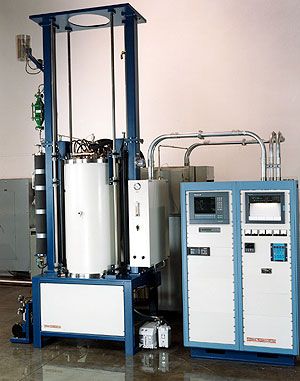Thermal Technology recently delivered a large Group 1700 automatic vacuum furnace/hydrogen furnace to the Argonne National Laboratory. Thermal Technology welcomed the opportunity to work with Argonne to meet their requirements for brazing in a variety of different applications.

The Argonne specification requires the furnace to operate up to 1600°C in a hydrogen atmosphere or vacuum. To meet these goals Thermal Technology supplied a model APF‑1836-MS furnace system. The APF-1836 is a bell-jar type furnace with the main heating element measuring 18 inches in diameter by 36 inches high, providing a work zone 15 inches in diameter by 30 inches high. The heating element is fabricated from molybdenum sheet and provides approximately 2000 square inches of radiating surface area facing the work. Trim heaters,manufactured of molybdenum stock, are installed at each end of the work zone to insure a high degree of temperature uniformity. Fully automatic process control and unattended operation are facilitated by a Honeywell controller/programmer with a multi-loop workstation.
Similar systems to the one shipped to Argonne have been successfully applied to other processes such as co-firing of metallized ceramic products and sintering of metals and ceramics. These types of systems have been supplied for use at temperatures up to 2500°C and are in production and R & D facilities around the world.
The nation’s first national laboratory, Argonne National Laboratory conducts basic and applied scientific research across a wide spectrum of disciplines, ranging from high-energy physics to climatology and biotechnology. Argonne is operated by the University of Chicago as part of the U.S. Department of Energy’s national laboratory system.
At Thermal Technology our primary goal is to provide customers with superior quality high-temperature furnace systems that meet their requirements in a cost-effective manner. We enjoy technical challenges, and we strive to continuously improve the design of our equipment, efficiency of our manufacturing, and effectiveness of our communications.
